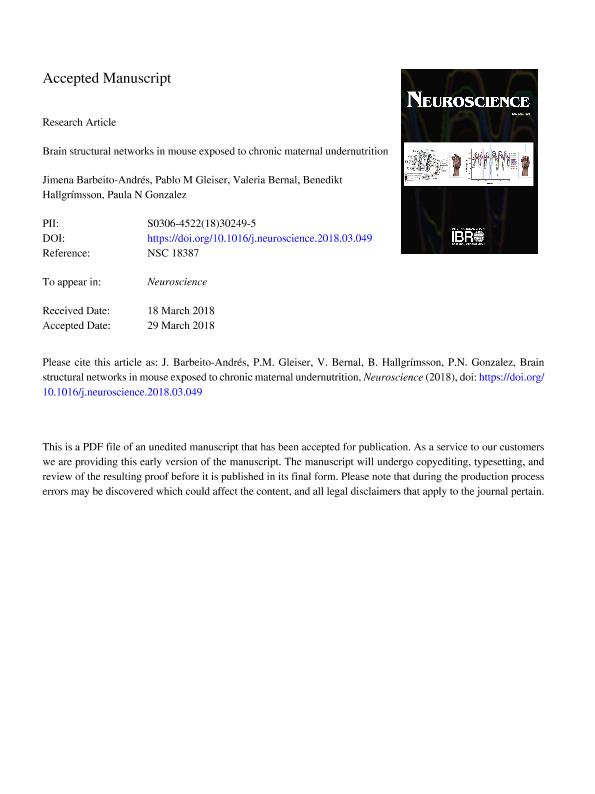Mostrar el registro sencillo del ítem
dc.contributor.author
Barbeito Andrés, Jimena

dc.contributor.author
Gleiser, Pablo Martin

dc.contributor.author
Bernal, Valeria

dc.contributor.author
Hallgrimsson, Benedikt

dc.contributor.author
Gonzalez, Paula Natalia

dc.date.available
2020-06-25T14:03:43Z
dc.date.issued
2018-06-01
dc.identifier.citation
Barbeito Andrés, Jimena; Gleiser, Pablo Martin; Bernal, Valeria; Hallgrimsson, Benedikt; Gonzalez, Paula Natalia; Brain Structural Networks in Mouse Exposed to Chronic Maternal Undernutrition; Pergamon-Elsevier Science Ltd; Neuroscience; 380; 1-6-2018; 14-26
dc.identifier.issn
0306-4522
dc.identifier.uri
http://hdl.handle.net/11336/108186
dc.description.abstract
Brain structural connectivity is known to be altered in cases of intrauterine growth restriction and premature birth, although the specific effect of maternal nutritional restriction, a common burden in human populations, has not been assessed yet. Here we analyze the effects of maternal undernutrition during pregnancy and lactation by establishing three experimental groups of female mice divided according to their diet: control (Co), moderate calorie-protein restriction (MCP) and severe protein restriction (SP). Nutritionally restricted dams gained relatively less weight during pregnancy and the body weight of the offspring was also affected by maternal undernutrition, showing global growth restriction. We performed magnetic resonance imaging (MRI) of the offspring's brains after weaning and analyzed their connectivity patterns using complex graph theory. In general, changes observed in the MCP group were more subtle than in SP. Results indicated that brain structures were not homogeneously affected by early nutritional stress. In particular, the growth of central brain regions, such as the temporo-parietal cortex, and long integrative myelinated tracts were relatively preserved, while the frequency of short tracts was relatively reduced. We also found a differential effect on network parameters: network degree, clustering, characteristic path length and small-worldness remained mainly unchanged, while the rich-club index was lower in nutritionally restricted animals. Rich-club decrease reflects an impairment in the structure by which brain regions with large number of connections tend to be more densely linked among themselves. Overall, the findings presented here support the hypothesis that chronic nutritional stress produces long-term changes in brain structural connectivity.
dc.format
application/pdf
dc.language.iso
eng
dc.publisher
Pergamon-Elsevier Science Ltd

dc.rights
info:eu-repo/semantics/openAccess
dc.rights.uri
https://creativecommons.org/licenses/by-nc-nd/2.5/ar/
dc.subject
GROWTH RESTRICTION
dc.subject
BRAIN SPARING
dc.subject
COMPLEX GRAPHS
dc.subject
MAGNETIC RESONANCE IMAGING
dc.subject
RICH-CLUB
dc.subject.classification
Biología del Desarrollo

dc.subject.classification
Ciencias Biológicas

dc.subject.classification
CIENCIAS NATURALES Y EXACTAS

dc.title
Brain Structural Networks in Mouse Exposed to Chronic Maternal Undernutrition
dc.type
info:eu-repo/semantics/article
dc.type
info:ar-repo/semantics/artículo
dc.type
info:eu-repo/semantics/publishedVersion
dc.date.updated
2019-09-27T14:34:10Z
dc.journal.volume
380
dc.journal.pagination
14-26
dc.journal.pais
Estados Unidos

dc.journal.ciudad
Nueva York
dc.description.fil
Fil: Barbeito Andrés, Jimena. Universidad Nacional Arturo Jauretche. Unidad Ejecutora de Estudios en Neurociencias y Sistemas Complejos. Provincia de Buenos Aires. Ministerio de Salud. Hospital Alta Complejidad en Red El Cruce Dr. Néstor Carlos Kirchner Samic. Unidad Ejecutora de Estudios en Neurociencias y Sistemas Complejos. Consejo Nacional de Investigaciones Científicas y Técnicas. Centro Científico Tecnológico Conicet - La Plata. Unidad Ejecutora de Estudios en Neurociencias y Sistemas Complejos; Argentina. Comisión Nacional de Energía Atómica. Centro Atómico Bariloche; Argentina
dc.description.fil
Fil: Gleiser, Pablo Martin. Consejo Nacional de Investigaciones Científicas y Técnicas. Centro Científico Tecnológico Conicet - Patagonia Norte; Argentina. Comisión Nacional de Energía Atómica. Centro Atómico Bariloche; Argentina
dc.description.fil
Fil: Bernal, Valeria. Consejo Nacional de Investigaciones Científicas y Técnicas. Centro Científico Tecnológico Conicet - Patagonia Norte; Argentina. Comisión Nacional de Energía Atómica. Centro Atómico Bariloche; Argentina
dc.description.fil
Fil: Hallgrimsson, Benedikt. University of Calgary; Canadá
dc.description.fil
Fil: Gonzalez, Paula Natalia. Universidad Nacional Arturo Jauretche. Unidad Ejecutora de Estudios en Neurociencias y Sistemas Complejos. Provincia de Buenos Aires. Ministerio de Salud. Hospital Alta Complejidad en Red El Cruce Dr. Néstor Carlos Kirchner Samic. Unidad Ejecutora de Estudios en Neurociencias y Sistemas Complejos. Consejo Nacional de Investigaciones Científicas y Técnicas. Centro Científico Tecnológico Conicet - La Plata. Unidad Ejecutora de Estudios en Neurociencias y Sistemas Complejos; Argentina
dc.journal.title
Neuroscience

dc.relation.alternativeid
info:eu-repo/semantics/altIdentifier/doi/http://dx.doi.org/10.1016/j.neuroscience.2018.03.049
dc.relation.alternativeid
info:eu-repo/semantics/altIdentifier/url/https://www.sciencedirect.com/science/article/abs/pii/S0306452218302495?via%3Dihub
Archivos asociados
